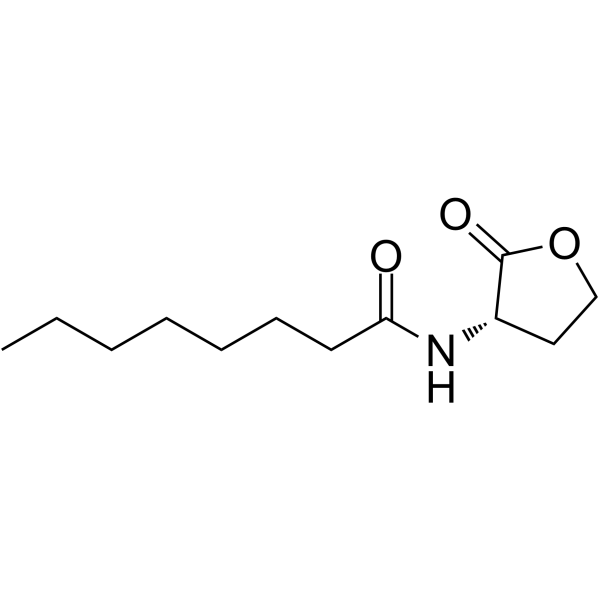Physicochemical Properties
| Molecular Formula | C12H21NO3 |
| Molecular Weight | 227.30 |
| Exact Mass | 227.152 |
| CAS # | 147852-84-4 |
| Related CAS # | N-Octanoyl-DL-homoserine lactone;106983-30-6 |
| PubChem CID | 6914579 |
| Appearance | Typically exists as solid at room temperature |
| Melting Point | 134-135°C (lit.) |
| LogP | 2.169 |
| Hydrogen Bond Donor Count | 1 |
| Hydrogen Bond Acceptor Count | 3 |
| Rotatable Bond Count | 7 |
| Heavy Atom Count | 16 |
| Complexity | 240 |
| Defined Atom Stereocenter Count | 1 |
| SMILES | O1C([C@]([H])(C([H])([H])C1([H])[H])N([H])C(C([H])([H])C([H])([H])C([H])([H])C([H])([H])C([H])([H])C([H])([H])C([H])([H])[H])=O)=O |
| InChi Key | JKEJEOJPJVRHMQ-JTQLQIEISA-N |
| InChi Code | InChI=1S/C12H21NO3/c1-2-3-4-5-6-7-11(14)13-10-8-9-16-12(10)15/h10H,2-9H2,1H3,(H,13,14)/t10-/m0/s1 |
| Chemical Name | N-[(3S)-2-oxooxolan-3-yl]octanamide |
| HS Tariff Code | 2934.99.9001 |
| Storage |
Powder-20°C 3 years 4°C 2 years In solvent -80°C 6 months -20°C 1 month |
| Shipping Condition | Room temperature (This product is stable at ambient temperature for a few days during ordinary shipping and time spent in Customs) |
Biological Activity
| Additional Infomation |
N-octanoyl-L-Homoserine lactone is a N-acyl-amino acid. N-(2-Oxotetrahydrofuran-3-YL)octanamide has been reported in Aliivibrio fischeri and Azospirillum lipoferum with data available. |
Solubility Data
| Solubility (In Vitro) | DMSO : 100 mg/mL (439.95 mM) |
| Solubility (In Vivo) |
Solubility in Formulation 1: 2.5 mg/mL (11.00 mM) in 10% DMSO + 40% PEG300 + 5% Tween80 + 45% Saline (add these co-solvents sequentially from left to right, and one by one), suspension solution; with sonication. For example, if 1 mL of working solution is to be prepared, you can add 100 μL of 25.0 mg/mL clear DMSO stock solution to 400 μL PEG300 and mix evenly; then add 50 μL Tween-80 to the above solution and mix evenly; then add 450 μL normal saline to adjust the volume to 1 mL. Preparation of saline: Dissolve 0.9 g of sodium chloride in 100 mL ddH₂ O to obtain a clear solution. Solubility in Formulation 2: 2.5 mg/mL (11.00 mM) in 10% DMSO + 90% (20% SBE-β-CD in Saline) (add these co-solvents sequentially from left to right, and one by one), suspension solution; with ultrasonication. For example, if 1 mL of working solution is to be prepared, you can add 100 μL of 25.0 mg/mL clear DMSO stock solution to 900 μL of 20% SBE-β-CD physiological saline solution and mix evenly. Preparation of 20% SBE-β-CD in Saline (4°C,1 week): Dissolve 2 g SBE-β-CD in 10 mL saline to obtain a clear solution. Solubility in Formulation 3: ≥ 2.5 mg/mL (11.00 mM) (saturation unknown) in 10% DMSO + 90% Corn Oil (add these co-solvents sequentially from left to right, and one by one), clear solution. For example, if 1 mL of working solution is to be prepared, you can add 100 μL of 25.0 mg/mL clear DMSO stock solution to 900 μL of corn oil and mix evenly. (Please use freshly prepared in vivo formulations for optimal results.) |
| Preparing Stock Solutions | 1 mg | 5 mg | 10 mg | |
| 1 mM | 4.3995 mL | 21.9974 mL | 43.9947 mL | |
| 5 mM | 0.8799 mL | 4.3995 mL | 8.7989 mL | |
| 10 mM | 0.4399 mL | 2.1997 mL | 4.3995 mL |
